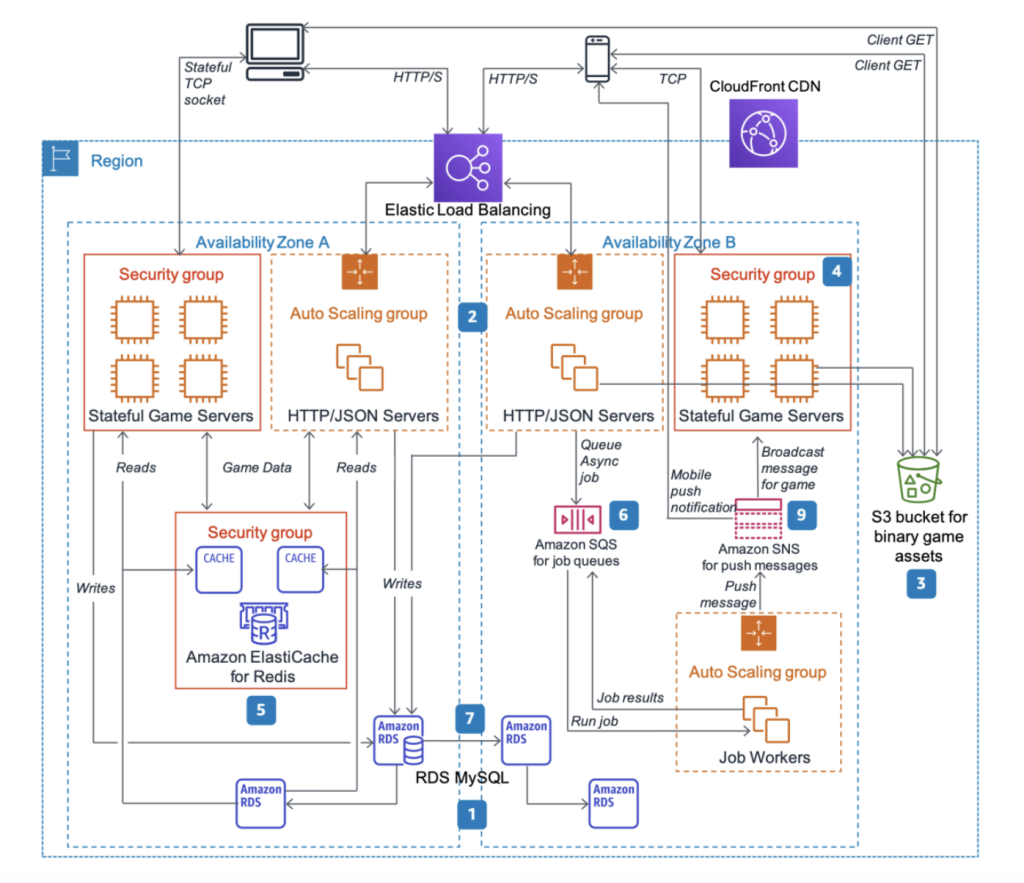The key to building a customer-centric sports betting application is creating a user-centric design and adding robust security measures to protect user information. Conduct extensive pre-development and divide the development process into phases, including front-end, back-end, API integration, and testing.
To ensure you build a secure and scalable sports betting app, it’s important to understand every step. Remember, it’s a lucrative market with immense potential, so following the right approach is mission-critical.
Building the Architecture for a Scalable Betting Application
An application’s architecture is responsible for its reliability, performance, and security. The right architecture lays the foundation for a scalable application, and without one, the application can crash during peak betting seasons, which affects user satisfaction.
Key Considerations for Building a Scalable Application
Scalable applications have a modular architecture with a microservices-based approach. This approach enables components to work independently, making the entire system more flexible and scalable.
- Real-Time Odds Engine: Sports betting systems thrive on real-time updates, so build a dedicated microservice for odds calculation and updates to ensure they can handle dynamic and large-volume requests.
- Bet Placement Engine: Create a highly responsive bet placement engine, which ensures all bets are placed without delays. More importantly, the system must handle all bet cancellations and disputes quickly.
- Use Hybrid Data Management Approach: For scalable sports betting applications use SQL for structured data and NoSQL for unstructured data. This means user profile bets are handled by SQL and event logs; user behavior is handled by NoSQL.
- Work with a Cloud-Native Infrastructure: When you adopt a cloud-native architecture by using platforms like AWS, Google Cloud, or Azure it’s easier to auto-scale resources adjusted according to the demand.
- Use Load Balancing Approach: With load balancing, you can distribute the traffic evenly on different servers, effectively reducing the risk of server overloads.
- Content Delivery Network: Instead of letting content load whenever requested, use a CDN to cache static content. This reduces latency by speeding up page loads.
Step-by-Step Process to Build a Sports Betting Application
A strategic and well-planned development approach is the secret to building a successful sports betting application. Not only the technical aspects, you also need to ensure the application has a good aesthetic appeal.
1. Research, Planning, and Obtaining the License

The sports betting industry will grow in the next decade. Begin your journey in this industry with extensive planning and research into the market situation, gaps you can fill, and the regulations you need to follow.
Once you have an idea about the market and are confident about building a product that can challenge the status quo, obtain the required licenses. According to your country’s regulations, apply for and obtain the necessary licenses, check regulations, and build a compliance structure.
2. Design and Prototyping
Focus on UI/UX design as it plays a critical role in user retention and user satisfaction. Start by creating wireframes and mockups to visualize the application layout and user flow.
Next, design an intuitive mobile-first interface with a focus on easy navigation, customer-centric colors, typography, etc. With all these aspects, we decided to develop clickable prototypes and use them to gather user feedback. Improve the designs based on the feedback.
3. Choose the Right Technology Stack
For developing a sports betting app, you need to divide the development exercise into phases, front-end, back-end, and API integration. The technologies used for each phase are different along with the approach.
- Front-end Development: For front-end framework, you can choose between React, and Angular, among other front-end development technologies. Choose them based on the capability to build responsive and fast-loading interfaces.
With front-end development, your focus should be on adding responsiveness, cross-browser compatibility, and design consistency while optimizing everything for speed.
- Back-end Development: Node.js, Django, and Spring Boot are some of the popular choices for back-end development. Ensure the technology you choose can build a robust architecture.
Well-planned backend development instructs you to follow the microservices approach to achieve modular functionality, which is required for scaling the application.
Ensure the app’s security also comes in backend development, and here are the practices to follow;
- Follow secure coding practices for preventing SQL injection cross-site scripting (XSS).
- Use SSL/TLS protocols for encrypting all sorts of communication.
- Add role-based access control (RBAC) for enhanced data protection.
4. Application Testing and Quality Assurance
Optimal results can only be guaranteed if you test and refine the application, ensuring it achieves all benchmarks. You need to test the application in various forms;
- Functional testing is done to verify all features work as intended.
- Load testing is done to check if the application can handle peak traffic and not slow down in terms of performance.
- Security testing is done to identify security lapses and address all vulnerabilities.
- User acceptance testing (UAT) is a way to collect feedback from beta users and refine the application further.
Use automation to build test scripts and complete the process faster. Automation can help with early bug detection, increase efficiency, and achieve comprehensive test coverage.
5. Deployment, App Launch, and Post-Launch Maintenance
Once all the quality checks are done and dusted, deploy the application using a CI/CD pipeline, which ensures a smooth deployment process. When launching the application, check the guidelines set forth by the App Store and Google Play Store.
Begin your marketing efforts before launching the application. Once launched, focus on post-launch maintenance by monitoring application performance and real user feedback.
Lastly, stay updated with regulatory changes and compliances depending on the country from where you are operating, as they might change without any prior notice.
Conclusion
Online sports betting is a lucrative business, which means for a new entrant in the market it will be a complex road ahead. But with the right combination of client-side and server-side development, the ideal set of features, and an intuitive design.
While developing the application, be laser-focused on ensuring your application is different and better than the competition. Focus on making your sports betting app customizable, scalable, and secure.



